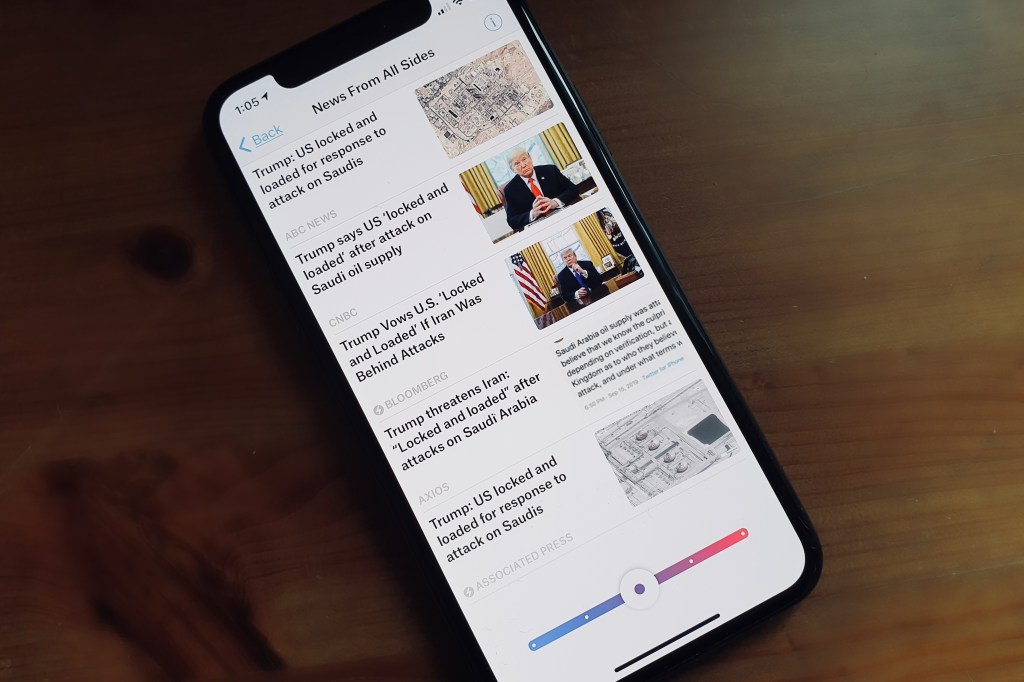Since launching in the United States five years ago, SmartNews, the news aggregation app that recently hit unicorn status, has quietly built a reputation for presenting reliable information from a wide range of publishers. The company straddles two very different markets: the U.S. and its home country of Japan, where it is one of the leading news apps.
SmartNews wants readers to see it as a way to break out of their filter bubbles, says Jeannie Yang, its senior vice president of product, especially as the American presidential election heats up. For example, it recently launched a feature, called “News From All Sides,” that lets people see how media outlets from across the political spectrum are covering a specific topic.
The app is driven by machine-learning algorithms, but it also has an editorial team led by Rich Jaroslovsky, the first managing editor of WSJ.com and founder of the Online News Association. One of SmartNews’ goal is to surface news that its users might not seek out on their own, but it must balance that with audience retention in a market that is crowded with many ways to consume content online, including competing news aggregation apps, Facebook and Google Search.
In a wide-ranging interview with Extra Crunch, Yang talked about SmartNews’ place in the media ecosystem, creating recommendation algorithms that don’t reinforce biases, the difference between its Japanese and American users and the challenges of presenting political news in a highly polarized environment.
Catherine Shu: One of the reasons why SmartNews is interesting is because there are a lot of news aggregation apps in America, but there hasn’t been one huge breakout app like SmartNews is in Japan or Toutiao in China. But at the same time, there are obviously a lot of issues in the publishing and news industry in the United States that a good dominant news app might be able to help, ranging from monetization to fake news.
Jeannie Yang: I think that’s definitely a challenge for everybody in the U.S. With SmartNews, we really want to see how we can help create a healthier media ecosystem and actually have publishers thrive as well. SmartNews has such respect for the publishers and the industry and we want to be good partners, but also really understand the challenges of the business model, as well as the challenges for users and thinking of how we can create a healthier ecosystem.
Initially, we were very small [in the U.S.] and one of the things I was really impressed by when I started talking to SmartNews was that they didn’t hire an engineer, designer or marketing first. They hired Rich [Jaroslovsky], who is our chief journalist and VP of content.
I thought that showed they had recognition and respect for the media industry. It wasn’t just “let’s try to scrape content and then we’ll figure that out later.” They recognized that having Rich and his experience and journalism background would help us vet the quality of content. That was critical because we’re about delivering quality information, but also building the bridge to media publishers.
Making algorithms that don’t reinforce filter bubbles

Shu: I think that at every kind of platform that serves as a content aggregation service, there’s a human team and then algorithms, and the question is how well the two actually work together. Your editorial team have journalism backgrounds and then of course the algorithms are really important to SmartNews’ business. In terms of what app users see, how does the editorial team work alongside the algorithms?
Yang: I do want to clarify that we are very much machine-learning driven, because we believe that this will have less bias and let people break out of their filter bubbles and surface hidden gems. I don’t know if it’s the silver bullet, but we believe there’s a combination of algorithms plus humans that will actually deliver the hidden gems.
When we think about machine-learning and AI-driven stuff, I think one thing to understand is that it is like a baby. It needs parenting. You can tell a toddler, here’s a bird, and they will recognize it, but you have to give a machine a thousand photos of a bird before they actually recognize it’s a bird, and if a new bird comes up, they might not recognize it anymore.
We believe machine learning can help us break out of our filter bubbles and we do that by understanding that building a bias-free algorithm is very difficult because it’s humans writing it, reading it and importing biases into what they do. What our editors do is start from the source.
First of all, we’re not crawling everything. We look at the journalism sources that we partner with, so there’s the initial vetting. Then the machine crawls through their articles and we review the output, just roughly, to see if there are any issues. For example, the team wants to make sure it makes sense if something is put in Top News.
Shu: How do you pick the kinds of stories that get featured in the Top News tab?
Yang: To be clear, what surfaces on Top News is not driven by our editors, it’s all driven by machine learning and what people are reading. There’s no human placement at all.
Shu: Let’s talk about filter bubbles because that’s obviously become a huge issue over the past few years. But at the same time, it’s what keeps people coming back to a lot of platforms, because they’ll see stuff that reinforces their interests and views of the world. One of SmartNews’ objectives is helping people leave those bubbles. How do you balance doing that with making sure people want to come back?
Yang: That is incredibly challenging. We have personalized discovery and our belief is that there is a way to help the algorithm help you discover new things. The idea is serendipity, that you’ll see something you didn’t think about as you were searching for something else and it comes up as a related topic.
If you look at how the app is designed, we have the “For You” section, but it’s not completely tailored to what you have read. We also introduce other topics that you may not be immediately interested in, but will hopefully look at over time. That’s definitely something that we’re working on.
The biggest challenge then is, how do you quantify that? Because as a business, we do have metrics, we have KPIs that we have to align to. The question is, what signal are you optimizing on? A lot of the things that are used to signal optimization are done at the point of interaction.
Most algorithms are like, did you click right now? Did it invoke an immediate reaction or not? And if it didn’t, then that must not be good. But what I think we need to start thinking about is time. Maybe you didn’t immediately click on something, but you might see it later and be more open to looking at it.
It’s about modeling how people discover things in their lives. But that’s also the tricky part, because we do need to show business results. This is something that we are working on and don’t have the answer to yet, but that probably the whole community is thinking about, not just us.
SmartNews versus social media platforms
Shu: There’s research that shows one of the reasons people keep coming back to Facebook and other social media for news is simply the convenience, because they already have accounts and don’t have to sign up or log in, they can just open the app. But with SmartNews, you don’t have to sign up for an account first like a lot of other apps. Since you don’t get a lot of demographic data from new users, how does the algorithm know what they’ll want to see if they haven’t read a lot of articles yet?
Yang: Initially it’s about surfacing the articles that people are reading across the spectrum. People read traditional newspapers back to back, whether the articles were targeted to them or not. We’re not saying that you must read all the content, but we’re taking a broad spectrum of what people are looking at and surfacing that. As users engage more, then we get down to that personalized discovery.
Shu: I read that SmartNews is focusing on the 25 years old and above demographic. It also feels different than Facebook, Instagram or Twitter, it’s more text-heavy. What have you learned about your audience over the past few years and what they want?
Yang: Our audiences do tend to be older. They tend to be more plugged in and already avid newsreaders. These are people who are looking for, and often already reading, multiple news sources. They might use Facebook or Twitter already, but they would like other sources as well.
If you look at the design, the aesthetics are very different than apps with a feed. We have talked a lot about the app’s information density, the readability and how people process information. I think that was evident from when the app started in Japan and we’ve brought that over to the English language.
The SmartView mode was initially created to get people to read quickly on the train without WiFi access. We’re thinking about the usability of the app on a small mobile device and the density of information and that maybe shapes the kind of people who are attracted to it right now.
SmartNews in Japan compared to the United States

Shu: I think that’s interesting, because when I looked at SmartNews, it reminded of the articles I’ve read about the differences in website design between Asia and the U.S., especially in terms of information density. What are the differences between the Japanese and American versions of SmartNews, and how might they have influenced one another?
Yang: This is something we’re still learning about as we dig into it deeper, but there are some main things that have shown up and we’re trying to figure out if it’s because of regional or design differences. Japanese readers are much more comfortable swiping horizontally and hitting multiple tabs, while readers in the U.S. are vertical scrollers.
That’s one of our main challenges because we have these channels, but readers in the U.S. aren’t necessarily discovering these channels as much. We know that once people do discover the channels with topics they are interested in, they start going through it. But in the U.S., the vertical scroll feed is much more comfortable, or maybe it’s just because they are used to it.
The other thing that is interesting is that the time spent reading by our most engaged readers in Japan and the U.S. is pretty close, but when we look at the numbers of articles they read and the number of impressions they make, the U.S. users read less articles and headlines in the same amount of time than the Japanese users.
We have several hypotheses, but it’s not clear what that means. Is it the length of articles in English, the types of articles or the speed of reading?
The time spent is very close, but the number of articles read is dramatically different. That’s one of the things we’re trying to understand, because then what does engagement mean in each place? Should we be trying to push up the number of page views in the U.S. to be the same as in Japan?
Shu: In terms of topics, what kind of similarities or differences have you seen between the type of content that people in each place tend to gravitate to?
Yang: People want to read the serious news articles, but in both the regions, the entertainment-related articles or humor are what people gravitate toward. There are different topics in Japan as well that don’t exist in the U.S. We have an anime or manga channel in the Japanese news app and one of the questions the Japanese team is thinking about is how to display those.
How SmartNews fits into the media landscape
Shu: Your competitors aren’t necessarily just other news aggregation apps, it’s also Google Search and Facebook.
Yang: It’s hard to say these are competitors because we look at three main categories of ways to consume the news. The first is publisher apps and we’re partners with them as well, so the question is not necessarily about competing with them, but expanding their base because we can offer things that they don’t, like for example local news.
Then there are news aggregation apps, like Google News, and right now we’re thinking of a different way to deliver information to you. And the third category is social media and messaging apps, but I also don’t necessarily think of them as competition, but as part of an ecosystem, because how are people going to find articles to post on Facebook for other people to read? I think there is symbiosis going on there.
Maybe one way to think about it is that it’s not necessarily about competition, but about SmartNews powering the watercooler conversation. How do we power it for you and your group of friends?
Obviously we’re all going for the same users, but it’s an ecosystem. For me it’s not necessarily about replacing something, but saying here’s a different offering for a different segment of users, and we can empower them to discover a publisher they had never even thought about.
Helping people make sense of politics

Shu: One of the things you mentioned when I wrote about the “News From All Sides” slider feature is that you talked to people in different parts of the U.S. I thought that was interesting because a lot of startups tend to focus on the cohort of people they are already around. But personally, I know that because of my background, I’ve been in coastal bubbles, and I have to make sure that it doesn’t become a blinder.
Yang: We went to Raleigh, North Carolina and Minneapolis, Minnesota and had six hours of focus groups. Each group had about 12 people. It’s really important for us to expand and talk to people, especially not in coastal cities. Our focus groups weren’t about just about the app.
They were also simply asking about their news reading habits and especially how they are processing political and election news. It was fascinating, because different groups of people have common pain points. In Raleigh, North Carolina, we understood that people were more on the conservative side of the spectrum and in Minneapolis they were more on the liberal spectrum.
We wanted to find people on both spectrums, but what stood out to me was the commonality. For example, the awareness of algorithms. People are aware that if they click on an article, an app might start recommending them more stuff like it. So they have what I’d call a low-grade anxiety about if they should click on it, because they’ll think “I just want to find out what this might be about, but I don’t want it to be in my feed all the time.”
There’s also very much an awareness that they might be in a filter bubble. It’s a common pain point, but expressed in different words and emotions. On one side, there are people who have that awareness and are like “oh well,” but on the other side they are aware of it and alarmed.
Shu: The “News From All Sides” slider definitely feels like a safer way to look at different points of view, because often when you encounter news on publisher sites or on social media, you see a lot of comments that really don’t reflect people at their best. Obviously the campaign is going to be a huge, divisive thing over the next year and focus even more attention on some of the same issues as last time. Has SmartNews started thinking of other products along the lines of the slider to address that?
Yang: We’re definitely thinking of how we can evolve this. The idea is that recognizing that there will be an overwhelming amount of information and the temperature will rise more and more.
So we are thinking of the next iteration of the slider and improving various aspects of it. We’re still learning so much. I wouldn’t be so brash to say that SmartNews is the answer, but everyone is looking at this set of problems and are very aware of it.































Comment